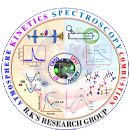We report rate coefficients for the relaxation of OH(v = 1) and OD(v = 1) by H2O and D2O as a function of temperature between 251 and 390 K. All four rate coefficients exhibit a negative dependence on temperature. In Arrhenius form, the rate coefficients for relaxation (in units of 10−12 cm3 molecule−1 s−1) can be expressed as: for OH(v = 1) + H2O between 263 and 390 K: k = (2.4 ± 0.9) exp((460 ± 115)/T); for OH(v = 1) + D2O between 256 and 371 K: k = (0.49 ± 0.16) exp((610 ± 90)/T); for OD(v = 1) + H2O between 251 and 371 K: k = (0.92 ± 0.16) exp((485 ± 48)/T); for OD(v = 1) + D2O between 253 and 366 K: k = (2.57 ± 0.09) exp((342 ± 10)/T). Rate coefficients at (297 ± 1 K) are also reported for the relaxation of OH(v = 2) by D2O and the relaxation of OD(v = 2) by H2O and D2O. The results are discussed in terms of a mechanism involving the formation of hydrogen-bonded complexes in which intramolecular vibrational energy redistribution can occur at rates competitive with re-dissociation to the initial collision partners in their original vibrational states. New ab initio calculations on the H2O–HO system have been performed which, inter alia, yield vibrational frequencies for all four complexes: H2O–HO, D2O–HO, H2O–DO and D2O–DO. These data are then employed, adapting a formalism due to Troe (J. Troe, J. Chem. Phys., 1977, 66, 4758), in order to estimate the rates of intramolecular energy transfer from the OH (OD) vibration to other modes in the complexes in order to explain the measured relaxation rates—assuming that relaxation proceeds via the hydrogen-bonded complexes. Graphical abstract: The relaxation of OH (v = 1) and OD (v = 1) by H2O and D2O at temperatures from 251 to 390 K
-
Call
-
E-mail
Journal Details
1. Kinetics of Quenching of OH (v=1) and OD (v=1) by H2O and D2O from 260 to 370K..
David C. McCabe, B. Rajakumar, P. Marshall, I. W. M. Smith, A. R. Ravishankara. Phys. Chem. Chem. Phys, , 4563-94., 8
